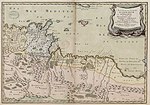| History of Tunisia |
|---|
 |
|
|
This article may be too long to read and navigate comfortably. When this tag was added, its readable prose size was 20,000 words. (August 2023) |

The present day Republic of Tunisia, al-Jumhuriyyah at-Tunisiyyah, is situated in Northern Africa. Geographically situated between Libya to the east, Algeria to the west and the Mediterranean Sea to the north.[1] Tunis is the capital and the largest city (population over 800,000); it is near the ancient site of the city of Carthage.
Throughout its recorded history, the physical features and environment of the land of Tunisia have remained fairly constant, although during ancient times more abundant forests grew in the north,[2] and earlier in prehistory the Sahara to the south was not an arid desert.[3][4]
The weather is temperate in the north, which enjoys a Mediterranean climate with mild rainy winters and hot dry summers, the terrain being wooded and fertile. The Medjerda river valley (Wadi Majardah, northeast of Tunis) is currently valuable farmland. Along the eastern coast the central plains enjoy a moderate climate with less rainfall but significant precipitation in the form of heavy dews; these coastlands are currently used for orchards and grazing. Near the mountainous Algerian border rises Jebel ech Chambi, the highest point in the country at 1544 meters. In the near south, a belt of salt lakes running east–west cuts across the country. Further south lies the Sahara desert, including the sand dunes of the Grand Erg Oriental.[5][6][7]
- ^ See map at end of article.
- ^ Cf., LaVerle Berry and Robert Rinehart, "The Society and Its Environment" pp. 71–143, 79, in Nelson (editor), Tunisia. A Country Study (Washington, D.C., 3rd ed. 1987).
- ^ Prior to 6000 years ago, evidently the vast Sahara region to the south was better watered, resembling a savanna and able to support herds; then a gradual desiccation process set in, leaving the parched desert it is today. Robert Rinehart, "Historical Setting" pp. 1–70, 4, in Nelson (editor), Tunisia. A Country Study (Washington, D.C., 3rd ed. 1987).
- ^ Emile F. Gautier, Le Sahara (Paris: Payot, 2nd ed. 1928), expanded edition translated by Dorothy Ford Mayhew as Sahara. The Great Desert (Columbia Univ. 1935) pp. 56–61.
- ^ Kenneth J. Perkins, Tunisia: Crossroads of the Islamic and European Worlds (Boulder, Colorado: Westview 1986) pp. 1–5.
- ^ Jamil M. Abun-Nasr, A History of the Maghrib (Cambridge Univ. 1971) pp. 1–6.
- ^ The World Factbook on "Tunisia".